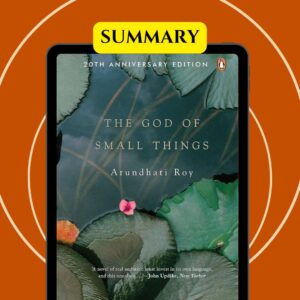God of Small Things Summary
Arundhati Roy is an acclaimed Indian author known for her powerful storytelling and social commentary. She achieved global recognition with her debut novel, The God of Small Things, which won the prestigious Booker Prize.
Background information on the novel
Set in Kerala, India, The God of Small Things delves into the lives of a dysfunctional family caught in the web of societal norms and personal desires. It intertwines themes of love, loss, and forbidden relationships within a complex narrative structure.
Significance of the title God of Small Things
The title reflects the novel’s exploration of how seemingly insignificant events and choices can have profound impacts on individuals and their relationships. It underscores the importance of paying attention to the minutiae of life.

Table of Contents
Character Analysis
Main characters in the novel
- Estha
- Rahel
- Ammu
- Velutha
Detailed analysis of Estha and Rahel
Estha and Rahel are twins whose lives are forever altered by a tragic event in their childhood. Their bond is central to the narrative as they navigate the challenges of family dynamics, societal expectations, and personal growth.
Secondary characters and their roles
- Mammachi: The twins’ grandmother, who struggles with her past and societal pressures.
- Chacko: Ammu’s brother, who embodies privilege and hypocrisy.
- Baby Kochamma: A manipulative figure who fuels tensions within the family.
- Velutha: A lower-caste worker whose forbidden relationship with Ammu sparks tragedy.
Plot Summary
Setting of the novel
The story unfolds in Ayemenem, a village in Kerala, where the caste system and colonial legacy shape the characters’ lives. The lush landscape serves as a backdrop for the unfolding drama of the dysfunctional family.
Overview of the storyline
The God of Small Things weaves a nonlinear narrative that explores the events leading to the twins’ traumatic experience and its aftermath. Through a series of flashbacks and present-day reflections, the story unravels the intricate dynamics of love, betrayal, and societal prejudice.
Key events and plot twists
- The arrival of Sophie Mol, a cousin from England, disrupts the twins’ world.
- Ammu’s forbidden love affair with Velutha sets off a chain of tragic events.
- The shocking revelation of the event that scarred the twins’ childhood changes everything.
Themes
Love and Forbidden Relationships
The novel examines the consequences of love that defies societal norms, highlighting the sacrifices individuals make for forbidden relationships and the societal backlash they face.
Social Hierarchies and Injustice
Through the lens of caste discrimination and privilege, the book exposes the oppressive structures that govern society and the impact of systemic injustices on individual lives.
History and Memory
God of Small Things delves into the weight of personal and collective histories on the characters’ identities, showcasing how past traumas shape their present realities and future paths.
Symbolism of the River in the novel
The river symbolizes the flow of time, memories, and emotions, serving as a metaphor for the characters’ journey through life’s turbulent waters and the inevitability of change and growth.
Literary Analysis
Writing Style and Language in the Novel
- Arundhati Roy’s writing style in God of Small Things can be described as lyrical and poetic, with a deep focus on vivid imagery and descriptive language that immerses the reader in the lush, evocative world she creates in Ayemenem, Kerala.
- The author employs a unique blend of English and Malayalam languages, capturing the local dialect and cultural nuances of the setting. This language fusion adds richness to the narrative and enhances the authenticity of the characters and their experiences.
- Roy’s use of metaphor and symbolism is skillfully woven throughout the novel, adding layers of meaning and depth to the storytelling. The intricate prose invites readers to engage with the text on multiple levels, uncovering hidden truths beneath the surface.
Narrative Structure and Use of Flashbacks
- The non-linear narrative structure of God of Small Things contributes to the complexity of the storytelling, with the plot unfolding through a series of interconnected flashbacks and present-day events.
- Roy masterfully interweaves past and present, creating a mosaic of memories and experiences that shape the characters’ identities and relationships. The fragmented timeline mirrors the characters’ fractured lives, offering insights into their motivations and struggles.
- By employing flashbacks, Roy invites readers to piece together the intricate puzzle of the narrative, gradually revealing the deep-rooted secrets and traumas that haunt the protagonists. The nonlinear approach adds suspense and depth to the plot, keeping readers engaged and intrigued till the end.
Exploration of Post-Colonial Themes
- God of Small Things delves into complex post-colonial themes that resonate with issues of power, identity, and resistance against historical oppressions.
- Roy interrogates the legacy of colonialism and its enduring impact on Indian society, particularly in terms of social hierarchies, cultural hegemony, and the erasure of indigenous voices.
- The novel critiques the Western gaze and colonial narratives that marginalize and exoticize the colonized, challenging readers to confront the complexities of post-colonial identities and relationships in a rapidly changing world.
Critical Reception
Reviews and Accolades Received by the Novel
- God of Small Things garnered widespread critical acclaim upon its publication, winning the prestigious Booker Prize in 1997 and establishing Arundhati Roy as a literary sensation.
- Renowned authors and critics praised Roy’s bold storytelling, lyrical prose, and insightful exploration of complex themes. The novel’s vivid characters and evocative setting were highlighted as standout features that captivated readers worldwide.
- The novel’s enduring popularity and critical acclaim underscore its significance in contemporary literature and its lasting impact on readers across diverse cultural landscapes.
Comparison with Other Works of Indian Literature
- In the realm of Indian literature, God of Small Things stands out as a groundbreaking work that reshaped the landscape of Indian English fiction.
- Scholars and critics have compared Roy’s literary style and thematic concerns to those of renowned Indian authors like Salman Rushdie, Arundhati Roy, and Vikram Seth.
- The novel’s nuanced exploration of family dynamics, forbidden love, and societal taboos has drawn parallels with classic Indian literary works while offering a fresh perspective on traditional themes.
Controversies Surrounding the Novel
- Despite its critical acclaim, God of Small Things has not been without its share of controversies. The novel’s frank portrayal of taboo subjects, such as incest and social hierarchies, sparked debates and discussions within literary circles and beyond.
- Some critics and readers raised objections to the novel’s depiction of sensitive themes, arguing that it crossed boundaries of propriety and cultural norms. However, supporters of the book defended Roy’s artistic vision and the authenticity of her portrayal of complex human emotions and relationships.
Impact on Literature and Society
Influence on Indian Literature and Writers
- God of Small Things has had a profound influence on Indian literature, inspiring a new generation of writers to explore themes of love, loss, and power dynamics in their works.
- The novel’s innovative narrative techniques and bold storytelling have reshaped the boundaries of Indian fiction, encouraging writers to experiment with form, language, and subject matter.
- Arundhati Roy’s success as a novelist and activist has made her a prominent figure in Indian literature and social discourses, demonstrating the power of storytelling to effect social change and challenge established norms.
Discussion of the Novel’s Themes in Contemporary Society
- The themes explored in God of Small Things, such as forbidden love, social injustice, and the legacy of colonialism, continue to resonate in contemporary society, sparking discussions on power dynamics, privilege, and cultural identity.
- Readers and scholars alike engage with the novel’s probing questions about family, gender, and caste, drawing parallels between the fictional world of Ayemenem and real-world issues of discrimination and inequality.
- By confronting uncomfortable truths and exposing hidden tensions, God of Small Things prompts readers to reflect on their own biases and assumptions, fostering empathy and understanding across diverse perspectives.
God of Small Things in the Context of Global Literature
- As a seminal work of Indian literature, God of Small Things has transcended national boundaries to become a global phenomenon, resonating with readers from different cultural backgrounds and literary traditions.
- The novel’s universal themes of love, loss, and longing speak to human experiences that transcend geographical and temporal divides, forging connections and fostering dialogue across borders.
- God of Small Things has been translated into multiple languages and continues to captivate readers around the world, cementing its place as a timeless masterpiece of contemporary literature.
FAQs for God of Small Things Summary
What is the main theme of God of Small Things by Arundhati Roy?
The main themes of God of Small Things include love and forbidden relationships, social hierarchies and injustice, and the impact of history and memory on relationships and society.
Who are the main characters in God of Small Things and what are their roles?
The main characters in the novel are Estha and Rahel, twins who experience tragic events that shape their lives. Other significant characters include Ammu, Velutha, and Baby Kochamma, who play pivotal roles in the storyline.
How does the setting of the novel contribute to the overall narrative?
The setting of Ayemenem in Kerala, India, acts as a vibrant backdrop that influences the characters’ actions and decisions. The lush scenery and cultural context add depth to the storyline, showcasing the complexities of society.
What is the significance of the river as a symbol in God of Small Things?
The river symbolizes a source of life and death, reflecting the interconnectedness of characters and events in the novel. It serves as a metaphor for the chaos and order that coexist in the characters’ lives.
How does Arundhati Roy’s writing style enhance the storytelling in God of Small Things?
Roy’s lyrical prose and evocative language bring the characters and settings to life, creating a vivid and immersive reading experience. Her use of imagery and symbolism enriches the narrative, engaging readers on multiple levels.
Conclusion:
In conclusion, God of Small Things by Arundhati Roy is a compelling and thought-provoking novel that delves into complex themes of love, social injustices, and the lasting impact of history. Through a richly detailed plot and nuanced character development, Roy crafts a literary masterpiece that continues to resonate with readers worldwide. By exploring the intricate relationships between characters and the underlying societal norms, the novel offers a profound reflection on the human experience and the delicate balance between joy and sorrow. Dive into the world of God of Small Things to uncover its hidden depths and timeless relevance.





